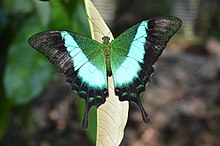
Summary
Papilio buddha, the Malabar banded peacock,[1][2] is a species of swallowtail butterfly found in the Western Ghats of India.[1][2][3] The Government of Kerala declared it as the official Kerala state butterfly. [1]
| Malabar Banded Peacock | |
|---|---|

| |
| Scientific classification | |
| Domain: | Eukaryota |
| Kingdom: | Animalia |
| Phylum: | Arthropoda |
| Class: | Insecta |
| Order: | Lepidoptera |
| Family: | Papilionidae |
| Genus: | Papilio |
| Species: | P. buddha
|
| Binomial name | |
| Papilio buddha Westwood, 1872
| |
Description edit
P. buddha resembles P. palinurus but is larger. The upperside of the wings also differ with the irroration of green scales more restricted, the outer half of the forewing except a triangular patch from the apex of wing downwards, and the outer third of the hindwing except a subterminal series of ill-formed lunules, devoid of green scales; discal transverse bands on both forewing and hindwings similar to those in P. palinurus but very much broader; the discal band of the forewing measured on the dorsum occupies considerably more than one-third of the dorsal length, while the discal band of the hindwing is as broad posteriorly as it is anteriorly (in P. palinurus it is much narrower posteriorly); the ochraceous tornal ocellus brighter, not surmounted with blue; the subapical ochraceous lunule in interspace 7 also brighter and much larger.[4]
The underside is similar to the underside of P. palinurus, but on the hindwing the ochraceous lunules in the subterminal series is proportionately narrower and much more conspicuously bordered on their innersides with silvery white. Antennae, head, thorax and abdomen as in P. palinurus.[4][5]
The wingspan is 107–155 mm.[citation needed]
Life history edit
The caterpillar has a shield on the thoracic segments. Green, the shield laterally and posteriorly narrowly edged with white; segments 5 to 11 with a broad white line and above it a series of minute white spots on each segment.
The pupa is curved ventrally, head cleft, the processes long and upturned, back and sides keeled; colour dark green ventrally, pale green dorsally (after Davidson and Aitken).[4]
- Life cycle
-
Egg
-
Larva
-
Chrysalis
-
Imago (dorsal view)
-
Imago (lateral view)
Host plants edit
The larva (caterpillar) has been recorded on Zanthoxylum rhetsa.[6]
Status edit
This species is locally common and not rare. It is protected in India but not known to be threatened.[citation needed]
See also edit
Cited references edit
- ^ a b Varshney, R.K.; Smetacek, Peter (2015). A Synoptic Catalogue of the Butterflies of India. New Delhi: Butterfly Research Centre, Bhimtal & Indinov Publishing, New Delhi. p. 5. doi:10.13140/RG.2.1.3966.2164. ISBN 978-81-929826-4-9.
- ^ a b Savela, Markku. "Papilio buddha Westwood, 1872". Lepidoptera and Some Other Life Forms. Retrieved 3 July 2018.
- ^ Westwood, John O (1872). Transactions of the Entomological Society of London. London: Royal Entomological Society of London. p. 500.
- ^ a b c One or more of the preceding sentences incorporates text from this source, which is in the public domain: Bingham, C.T. (1907). The Fauna of British India, Including Ceylon and Burma. Vol. II (1st ed.). London: Taylor and Francis, Ltd. pp. 89–90.
- ^ Moore, Frederic (1903–1905). Lepidoptera Indica. Vol. VI. London: Lovell Reeve and Co. pp. 69–71.
- ^ Ravikanthachari Nitin; V.C. Balakrishnan; Paresh V. Churi; S. Kalesh; Satya Prakash; Krushnamegh Kunte (10 April 2018). "Larval host plants of the buterfies of the Western Ghats, India". Journal of Threatened Taxa. 10 (4): 11495–11550. doi:10.11609/jott.3104.10.4.11495-11550 – via JoTT.
References edit
- Erich Bauer and Thomas Frankenbach, 1998 Schmetterlinge der Erde, Butterflies of the world Part I (1), Papilionidae Papilionidae I: Papilio, Subgenus Achillides, Bhutanitis, Teinopalpus. Edited by Erich Bauer and Thomas Frankenbach. Keltern: Goecke & Evers; Canterbury: Hillside Books ISBN 9783931374624
- Collins, N. Mark; Morris, Michael G. (1985). Threatened Swallowtail Butterflies of the World: The IUCN Red Data Book. Gland & Cambridge: IUCN. ISBN 978-2-88032-603-6 – via Biodiversity Heritage Library.
- Evans, W.H. (1932). The Identification of Indian Butterflies (2nd ed.). Mumbai, India: Bombay Natural History Society.
- Gaonkar, Harish (1996). Butterflies of the Western Ghats, India (including Sri Lanka) - A Biodiversity Assessment of a Threatened Mountain System. Bangalore, India: Centre for Ecological Sciences.
- Gay, Thomas; Kehimkar, Isaac David; Punetha, Jagdish Chandra (1992). Common Butterflies of India. Nature Guides. Bombay, India: World Wide Fund for Nature-India by Oxford University Press. ISBN 978-0195631647.
- Kunte, Krushnamegh (2000). Butterflies of Peninsular India. India, A Lifescape. Hyderabad, India: Universities Press. ISBN 978-8173713545.
- Wynter-Blyth, Mark Alexander (1957). Butterflies of the Indian Region. Bombay, India: Bombay Natural History Society. ISBN 978-8170192329.


